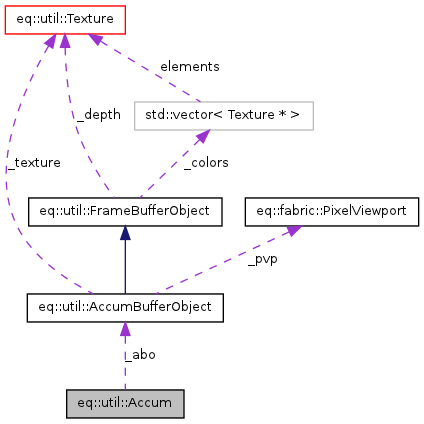|
Equalizer 1.0
|
eq::util::Accum Class Reference
A C++ class to abstract an accumulation buffer. More...
#include <accum.h>
 Collaboration diagram for eq::util::Accum:
Collaboration diagram for eq::util::Accum:Public Member Functions | |
| Accum (const GLEWContext *const glewContext) | |
| Construct a new accumulation buffer. | |
| ~Accum () | |
| Destruct the accumulation buffer. | |
| bool | init (const PixelViewport &pvp, GLuint textureFormat) |
| Initialize the accumulation buffer. | |
| void | exit () |
| Exit the accum buffer. | |
| bool | resize (const int width, const int height) |
| Resize the accumulation buffer. | |
| void | clear () |
| Clear the accumulation buffer. | |
| void | accum () |
| Accumulate a frame from the read buffer into the accumulation buffer. | |
| void | display () |
| Copy the result of the accumulation to the current draw buffer. | |
| uint32_t | getMaxSteps () const |
| Get the maximum number of accumulation steps possible. | |
| uint32_t | getNumSteps () const |
| Get the current number of accumulation steps done. | |
| void | setTotalSteps (uint32_t totalSteps) |
| Set the total number of accumulation steps that will be done. | |
| uint32_t | getTotalSteps () |
| bool | usesFBO () const |
| Test if the accumulation uses the FBO implementation. | |
| const GLEWContext * | glewGetContext () const |
Static Public Member Functions | |
| static bool | usesFBO (const GLEWContext *glewContext) |
Detailed Description
A C++ class to abstract an accumulation buffer.
Depending on the OpenGL version, an FBO or glAccum() is used.
Remark: MacOS systems seem to have a buggy implementation of glAccum(), and use a workaround which needs setTotalSteps() to set up the total number of accumulations done.
Constructor & Destructor Documentation
| eq::util::Accum::Accum | ( | const GLEWContext *const | glewContext | ) |
Construct a new accumulation buffer.
- Version:
- 1.0
| eq::util::Accum::~Accum | ( | ) |
Destruct the accumulation buffer.
- Version:
- 1.0
Member Function Documentation
| void eq::util::Accum::accum | ( | ) |
Accumulate a frame from the read buffer into the accumulation buffer.
- Version:
- 1.0
| void eq::util::Accum::clear | ( | ) |
Clear the accumulation buffer.
- Version:
- 1.0
| void eq::util::Accum::display | ( | ) |
Copy the result of the accumulation to the current draw buffer.
- Version:
- 1.0
| void eq::util::Accum::exit | ( | ) |
Exit the accum buffer.
- Version:
- 1.0
| uint32_t eq::util::Accum::getMaxSteps | ( | ) | const |
Get the maximum number of accumulation steps possible.
- Returns:
- the maximum number of steps.
- Version:
- 1.0
| uint32_t eq::util::Accum::getNumSteps | ( | ) | const [inline] |
| uint32_t eq::util::Accum::getTotalSteps | ( | ) | [inline] |
| bool eq::util::Accum::init | ( | const PixelViewport & | pvp, |
| GLuint | textureFormat | ||
| ) |
Initialize the accumulation buffer.
- Parameters:
-
pvp the pixel viewport. textureFormat the texture format.
- Returns:
- true if initialized successfully.
- Version:
- 1.0
| bool eq::util::Accum::resize | ( | const int | width, |
| const int | height | ||
| ) |
Resize the accumulation buffer.
- Parameters:
-
width the new width. height the new height.
- Returns:
- true if the accumulation buffer is correctly resized.
- Version:
- 1.0
| void eq::util::Accum::setTotalSteps | ( | uint32_t | totalSteps | ) | [inline] |
| bool eq::util::Accum::usesFBO | ( | ) | const |
Test if the accumulation uses the FBO implementation.
- Returns:
- true if the accumulation uses an FBO, false if it uses glAccum().
The documentation for this class was generated from the following file:
 1.0 by
1.0 by
 1.7.3
1.7.3
